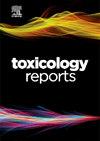藻蓝蛋白对赤霉素诱导的雌性大鼠及其后代小脑毒性的潜在保护作用
Q1 Environmental Science
引用次数: 0
摘要
赤霉素(GA3)是一种广泛使用的植物生长调节剂,可提高植株的大小和利用率;然而,其在妊娠期和哺乳期的潜在小脑毒性作用尚不清楚。藻蓝蛋白(PC)是一种天然抗氧化色素,对ga3诱导的小脑毒性的可能的神经保护作用尚未得到充分研究,特别是在妊娠和哺乳期。因此,本研究旨在评价PC对ga3诱导的大鼠及其子代小脑毒性的保护作用。将24只怀孕Wistar大鼠随机分为4组。第一组(管制组)接收车辆。II组(PC处理):给予PC(200 mg/kg体重)。iii组(GA3处理):给予GA3(55 mg/kg体重)。IV组(GA3 +PC处理):同时给予GA3(55 mg/kg体重)和PC(200 mg/kg体重)。所有的治疗都是在怀孕期间和分娩后两周内每天口服给药。对小脑皮层进行光镜和超微结构分析。测定小脑组织的氧化应激参数谷胱甘肽过氧化物酶(GPX)、超氧化物歧化酶(SOD)和脂质过氧化(LPO)。采用双向方差分析(Python和谷歌CoLab)对数据进行分析。结果显示,GA3给药可引起雌性大鼠及其后代的小脑皮质退行性改变和损伤,以及显著的氧化应激,表现为LPO升高,GPX和SOD水平降低。另一方面,同时给药PC显著改善了GA3暴露引起的组织学和生化改变。这些发现表明,补充PC可能为母鼠及其后代提供了一种有希望的保护策略,以对抗ga3诱导的小脑毒性。本文章由计算机程序翻译,如有差异,请以英文原文为准。
Potential protective effect of phycocyanin against gibberellic acid-induced cerebellar toxicity in female rats and their offspring
Gibberellic acid (GA3), a widely used plant growth regulator, enhances plant size and availability; however, its potential cerebellar toxic effects during pregnancy and lactation remain unclear. The possible neuroprotective role of phycocyanin (PC), a natural antioxidant pigment, against GA3-induced cerebellar toxicity has not been thoroughly investigated, particularly in pregnancy and lactation. Accordingly, the present study aimed to evaluate the protective effect of PC against GA3-induced cerebellar toxicity in mother rats and their offspring. A total of twenty-four pregnant Wistar rats were randomly divided into four groups. Group I (Control) received the vehicle. Group II (PC-treated): received PC (200 mg/kg body weight). Group-III (GA3-treated): received GA3 (55 mg/kg body weight). Group IV (GA3 +PC-treated): received both GA3 (55 mg/kg body weight) and PC (200 mg/kg body weight). All treatments were administered daily via the oral route to the mothers throughout pregnancy and for two weeks after delivery. Light-microscopic and ultrastructural analysis of the cerebellar cortex was performed. The oxidative stress parameters glutathione peroxidase (GPX), superoxide dismutase (SOD) and lipid peroxidation (LPO) in cerebellar tissues were assessed. The data were analyzed using two-way ANOVA (Python and Google CoLab). The results revealed that GA3 administration caused degenerative alterations and damage in the cerebellar cortex, as well as significant oxidative stress, evidenced by increased LPO and decreased GPX and SOD levels in female rats and their offspring. On the other hand, co-administration of PC significantly ameliorated the histological and biochemical alterations induced by GA3 exposure. These findings suggest that PC supplementation may offer a promising protective strategy against GA3-induced cerebellar toxicity in both mother rats and their offspring.
求助全文
通过发布文献求助,成功后即可免费获取论文全文。
去求助
来源期刊

Toxicology Reports
Environmental Science-Health, Toxicology and Mutagenesis
CiteScore
7.60
自引率
0.00%
发文量
228
审稿时长
11 weeks
 求助内容:
求助内容: 应助结果提醒方式:
应助结果提醒方式:


